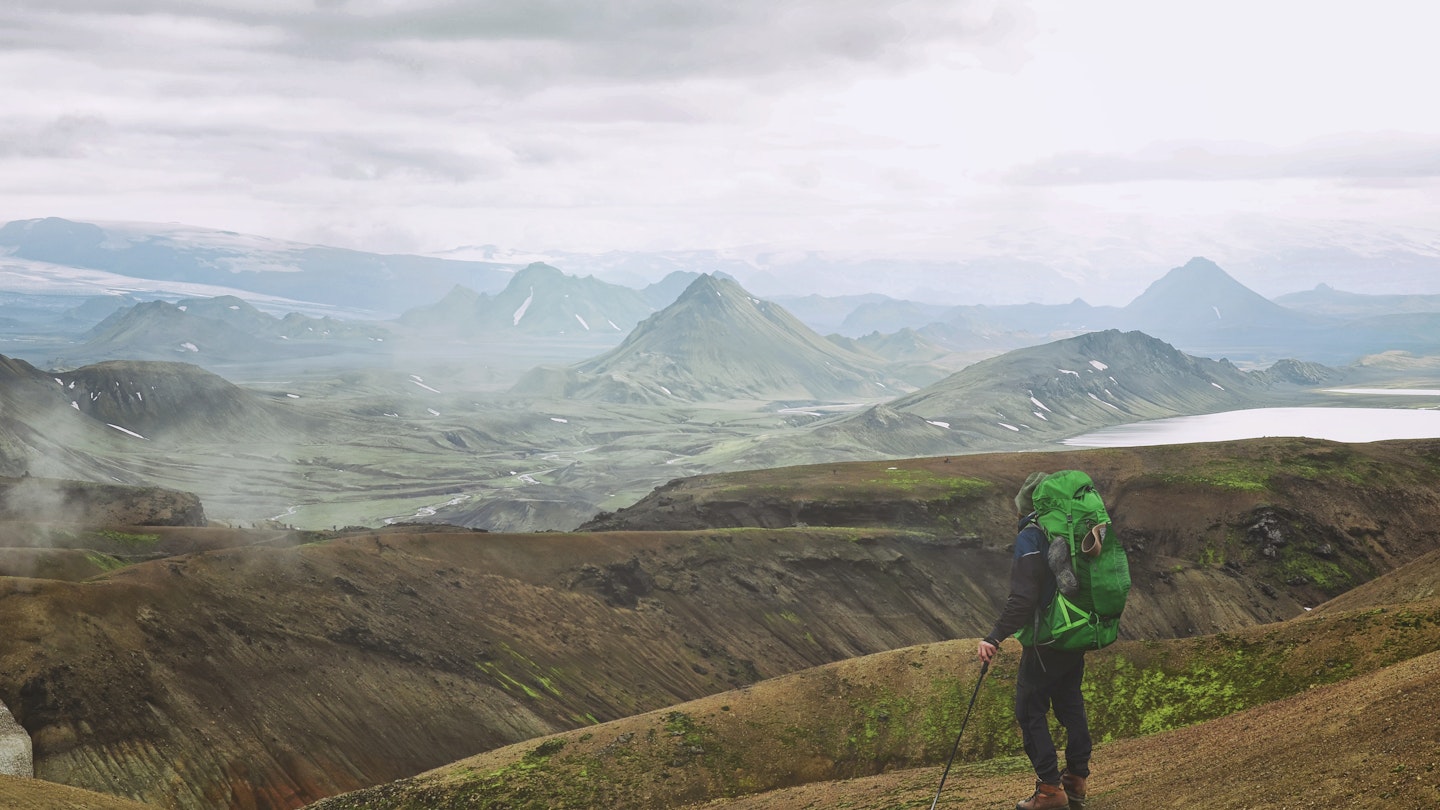With black volcanic deserts and verdant valleys, steaming geothermal springs and glacial rivers, plummeting ravines and precipitous ridges, it’s no wonder Iceland’s Laugavegur Trail is such a legendary hiking trail.
On top of the spectacular, otherworldly landscape, it’s comfortably doable in a week, including flying in and out of Reykjavik. So what should you bring to make the most of it?
Getting Your Bearings
For many, their first Icelandic adventure will be the Laugavegur Trail – and with very good reason. The Laugavegur stretches some 53km, starting at Landmannalaugar Hut and trekking south over 4 days to huts at Hrafntinnusker, Alftavatn and Emstrur ending at Þórsmörk. Many hikers bolt on an additional day taking Fimmvorduhals Pass to the coast, culminating at the dramatic Skogafoss Waterfall.
Plan Out Every Piece of Your Wardrobe
Iceland’s geography and climate is no joke – the hoary old chestnut that ‘there’s no such thing as bad weather, only bad equipment’ finds full expression here. You need to be prepared for all conditions. This is a demanding hike, at times isolated, and the volatile weather can amplify that challenge.
Good quality, waterproof hiking boots that have already been broken in are essential here, as are decent walking socks. Consider brands like Meindl or Salomon for reliable options. Thin sock liners are also beneficial when trekking on consecutive days, as they reduce boot friction and the risk of blisters. Additionally, they help keep your feet warm.
A breathable waterproof jacket is a must, but be sure to pack some waterproof trousers as well, since South Iceland experiences considerable rain. Look for outerwear with Gore-Tex, which remains a top choice for waterproofing due to its breathability and durability. Thermal base layers made from Merino wool, like those from Icebreaker, are also highly recommended. Layer additional items such as a packable down jacket, fleece, and wickable tops. Always choose non-cotton materials for moisture management.
On Your Back
Depending on the type of trip, your luggage requirements will vary. Solo travelers should opt for a sturdy 65L backpack with good support, as you’ll need to carry all your supplies, including food. The Laugavegur is a well-trodden route, where huts are busy during peak season in mid-summer, but there are still lengthy stretches of wilderness to enjoy.
If trekking with a guided group, your main bag may be transported ahead by a vehicle service. In this case, a 65L expedition duffle is ideal, and a 25L day pack will suffice for daily hikes, carrying essentials like layers, water, and your camera.
Amphibious Expeditions
Expect to wade through several rivers on this adventure. You’ll likely need to cross Bratthalshvisl near Hvanngil, or Þrónga before Þórsmörk. Pay attention to your guides or do some research on how to cross rivers safely. These crossings can be swift and challenging, with shifting gravel banks.
A fall in icy water poses significant risks, including hypothermia from exposure. Therefore, sandals with straps or neoprene booties are crucial for safe crossings. It’s best to cross in groups, using linked arms for support. Walking poles can aid balance as well.
Don’t Forget Your Togs
Bring a swimsuit and keep it accessible. A popular stop is the Blue Lagoon, which offers a perfect introduction to Iceland’s geothermal attractions. You’ll also find opportunities to enjoy hot springs along the Laugavegur Trail, as its name translates to ‘the way of hot pools’.
Sleeping Tight
Accommodation on the trail typically features shared dorms with rubber mattresses; therefore, a sleeping pad is unnecessary. However, a 3/4 season sleeping bag is essential, and if you tend to feel cold, using a bag liner can help. It’s good practice to bring indoor footwear, like runners or sandals, since there’s a ‘boots off’ rule in the huts.
Other Hardware
For those navigating independently, a handheld GPS with mapping capabilities is recommended, along with a traditional map and compass as backups. While the trail is marked, fog and storms can obscure markings, so proper preparation is vital. Always inform someone of your plans and expected return.
Walking poles can reduce knee strain and assist with river crossings. Additionally, a head torch is invaluable for nighttime outings and reading in the dark. Don’t forget to pack toilet paper while you’re at it!

- Waterproof hiking boots with ankle support; spare laces
- Waterproof breathable shell jacket and trousers
- Packable down jacket and fleece
- Quick-dry hiking trousers
- Long/short sleeve tops – wickable; more layers rather than thicker ones
- Good walking socks and sock liners
- Warm hat and gloves
- Thermals (top & bottom)
- Packable towel – for rivers/springs
- Sandals with straps or neoprene socks/booties for wading
- Indoors shoes
- Walking poles
- Head torch for nighttime outings and reading
- Dry bag – to keep spare socks and layers dry
- Water bottle
- Small Thermos Flask – for a hot drink
- 3/4 season sleeping bag; liner option
- Ear plugs – to minimize dorm snoring
- Swimsuit
- First aid kit, including prescriptions, blister treatment, and survival blanket
- Personal toiletries, wet wipes, loo roll
- Sunglasses and sun protection
- GPS/Map/Compass if navigating
- All your food if you’re not with an organized group





